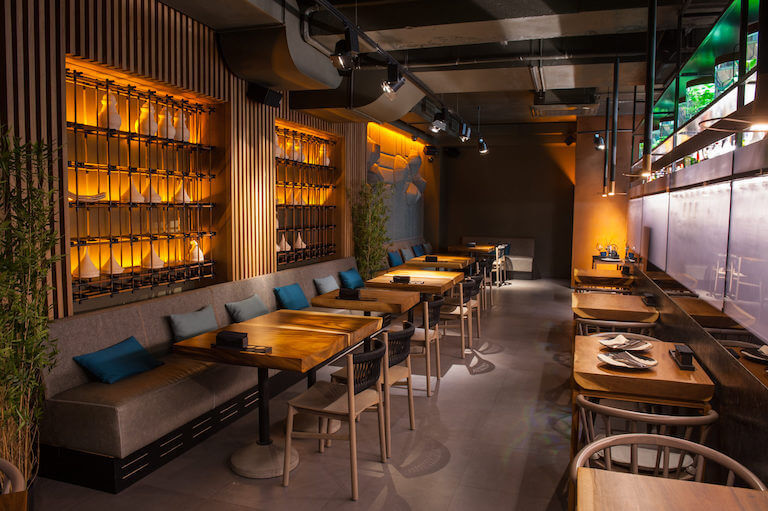Savor Genuine Eastern Food With a Pan-Asian Spin for a Culinary Journey
Beginning on a culinary trip via genuine Asian food, improved with a Pan-Asian twist, supplies an one-of-a-kind chance to check out the abundant tapestry of tastes that specify the region's diverse culinary practices. This experience invites you to enjoy the beautiful equilibrium of tastes-- sweet, salty, spicy, and sour-- integrated by aromatic natural herbs and seasonings. Picture the ingenious blend of Thai curry and ramen or the unforeseen pleasure of sushi burritos. As you contemplate these tempting recipes, take into consideration the social narratives and historical impacts that form them, each bite offering a story waiting to be discovered.

Checking Out Pan-Asian Tastes
In the world of global gastronomy, Pan-Asian cuisine sticks out for its remarkable variety and the harmonious interplay of flavors from different Oriental societies. This cooking technique celebrates the unique components and abundant traditions located across the continent, creating a tapestry of tastes that is both gratifying and interesting. Key to Pan-Asian food is its capability to stabilize different tastes-- wonderful, salty, spicy, and sour-- while highlighting the freshness and high quality of each component.
From the umami-rich soy sauce of Japan to the intense chili peppers of Thailand, Pan-Asian cuisine provides a considerable palette of flavors. These components are usually integrated in inventive means, boosting recipes with layers of intricacy. As an example, making use of great smelling natural herbs such as lemongrass and cilantro, common in Vietnamese and Thai food, includes a rejuvenating illumination to dishes, while the incorporation of coconut milk supplies a creamy, rich structure.
The emphasis on fresh fruit and vegetables and aromatic spices makes sure that each meal is not only a banquet for the taste but additionally for the senses. Pan-Asian cuisine welcomes diners to start a cooking trip, discovering the substantial and differed landscapes of Asian gastronomy with every bite.
Fusion Dishes to Try
While Pan-Asian cuisine is celebrated for its conventional tastes, the modern-day cooking landscape is progressively accepting fusion recipes that mix these classic aspects with impacts from other areas. This ingenious strategy not only honors the abundant heritage of Oriental cooking arts however additionally presents unique preference experiences that attract contemporary tastes.
A prime example of such a blend dish is the Korean-Mexican taco, where marinated bulgogi beef is covered in a warm tortilla, topped with kimchi and a zesty gochujang-infused salsa. This combination weds the bold, savory flavors of Korea with the vibrant, fresh components of Mexican cuisine. In a similar way, sushi burritos have gotten popularity, joining together the delicate creativity of Japanese sushi with the passionate, hand-held ease of a burrito, frequently including blend ingredients like tempura shrimp and avocado with a drizzle of wasabi mayo.
One more significant dish is Thai curry ramen, which infuses the velvety, fragrant spices of Thai curry right into the comforting broth of conventional Japanese ramen, producing a harmonious mix that entices the senses. These combination meals prolong past simple novelty; they represent a culinary discussion in between societies, encouraging expedition and technology worldwide of Pan-Asian food.
Important Active Ingredients and Seasonings
To truly value Pan-Asian cuisine, one must recognize the crucial active ingredients and flavors that create its foundation. This diverse cooking design attracts from a rich tapestry of Asian traditions, employing an unified mix of structures and flavors.
Aromatic components are pivotal, with garlic, lemongrass, and ginger being ubiquitous throughout various Pan-Asian dishes. These active ingredients give an aromatic base that enhances the intricacy of flavors. Spices such as celebrity anise, cardamom, and cinnamon present heat and character, echoing impacts from regions like China and India.

Cooking Techniques and Tips
Grasping the art of Pan-Asian food requires familiarity with its unique food preparation methods, each contributing to the vivid tapestry of tastes this cooking tradition is celebrated for. Central to these approaches is the stir-fry, a rapid cooking technique that preserves the dietary honesty and brilliant colors of ingredients. Making use of a wok, the stir-fry technique permits also warm distribution, crucial for achieving the characteristic texture and taste equilibrium of Pan-Asian recipes.
An additional essential strategy is steaming, particularly prevalent in Chinese cuisine. This gentle method maintains the natural tastes and nutrients of active ingredients, making it suitable for fish and shellfish and vegetables. Dumplings, a beloved staple, frequently take advantage of steaming, leading to soft, succulent textures.
Grilling, additionally integral, passes on smoky midsts to recipes such as Oriental bulgogi or Japanese yakitori (Best ambiance restaurants Islamabad). This strategy commonly includes marinating ingredients, allowing tastes to pass through deeply prior to cooking over an open flame or hot plate
Lastly, understanding the art of balancing tastes-- pleasant, sour, salted, bitter, and umami-- is important. Correctly layering these components can raise a dish from ordinary to phenomenal, using a complex and pleasing cooking experience that embodies the significance of Pan-Asian cuisine.
Eating Experiences Worldwide
Around the world, Pan-Asian food provides an unequaled dining experience, celebrated for its abundant tapestry of flavors and lively presentations. This cooking sensation has actually gone beyond social boundaries, capturing the hearts and palates of food enthusiasts worldwide. In cosmopolitan cities fresh York, click here for info London, and Sydney, Pan-Asian restaurants offer as melting pots where cooking customs from Thailand, Japan, China, and beyond assemble, providing restaurants with an eclectic mix of recipes that highlight the region's variety.
The international appeal of Pan-Asian cuisine lies in its capability to supply both credibility and advancement. Cooks masterfully wed standard active ingredients such as lemongrass, soy sauce, and miso with modern strategies, causing bar italia dishes that are both refreshingly new and acquainted. This blend allows diners to start a culinary journey that appreciates heritage while accepting modernity.
Furthermore, eating experiences are boosted through thoughtfully developed atmospheres that reflect the ethos of Pan-Asian looks. From minimal Japanese-inspired insides to dynamic Thai-themed spaces, each dining establishment uses an unique ambiance that complements the culinary offerings. Because of this, patrons are not merely consuming a dish however partaking in a social experience, making Pan-Asian dining a really global phenomenon.
Conclusion
The expedition of Pan-Asian cuisine offers an extensive understanding of the intricate interaction of tastes and culinary practices throughout Asia. By embracing blend meals such as Thai curry ramen and sushi burritos, the culinary trip not just highlights the flexibility of typical components however also showcases innovative modern strategies. This gastronomic experience, enriched by vital flavors and cooking techniques, provides an unique possibility to appreciate the cultural diversity and cooking virtuosity that specify Pan-Asian cuisine on an international range.
Embarking on a culinary trip through genuine Asian food, boosted with a Pan-Asian twist, offers an one-of-a-kind opportunity to discover the abundant tapestry of flavors that define the area's diverse culinary traditions.In the realm of international gastronomy, Pan-Asian cuisine stands out for its exceptional variety and the harmonious interaction of tastes from various Oriental cultures. Trick to Pan-Asian cuisine is its capability to stabilize contrasting tastes-- wonderful, salted, spicy, and sour-- while highlighting the quality and high quality of each active ingredient.
